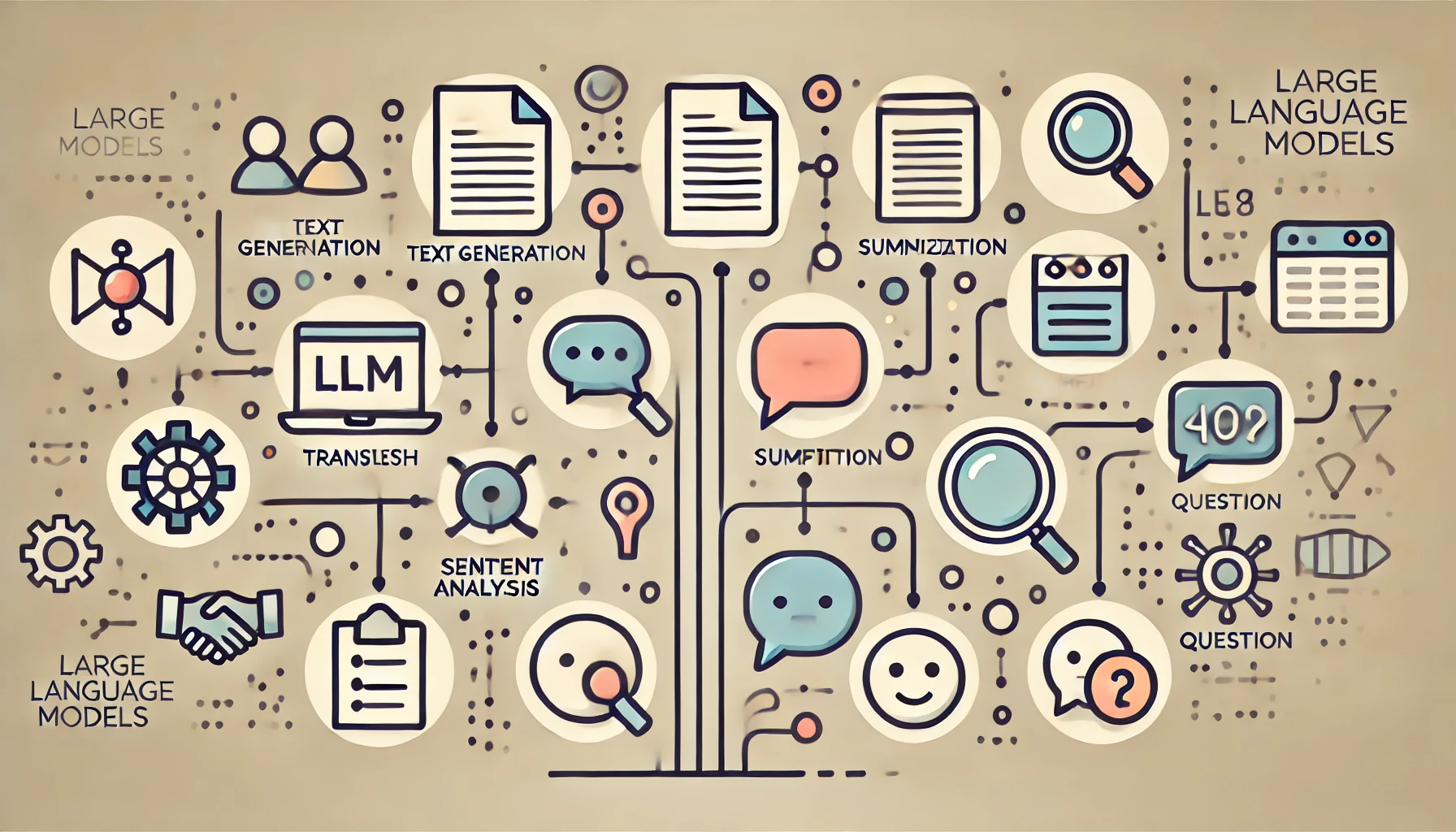Introduction
In recent years, Large Language Models (LLMs) have taken center stage in the field of Natural Language Processing (NLP). From powering chatbots to automating translation and content creation, LLMs are transforming the way we interact with technology. Their ability to generate human-like text has unlocked new possibilities across industries, bringing AI closer to understanding and replicating human communication.
This blog will explore what LLMs are, how they function, and their wide range of applications. We’ll also delve into the challenges these models pose, including resource demands and ethical considerations, and provide resources for those interested in learning more about this exciting area of AI.
1. What is a Large Language Model?
1.1 Definition
At their core, Large Language Models (LLMs) are a type of artificial intelligence model that leverage deep learning techniques to process and generate human-like text. Their strength lies in their ability to learn the nuances of human language through vast datasets, enabling them to predict, generate, and comprehend text in ways that mimic human responses.
One of the defining characteristics of LLMs is their large number of parameters—the internal weights the model learns during training. These parameters allow the models to capture complex linguistic patterns, making them effective at understanding context, tone, and meaning.
1.2 Scale of LLMs
The “large” in LLMs refers to the immense number of parameters these models possess, which can range from millions to billions. As the number of parameters increases, so does the model’s ability to understand intricate patterns in language, but at the cost of higher computational power.
For instance, BERT—a widely used LLM for NLP tasks—contains 110 million parameters, allowing it to perform well on tasks such as sentiment analysis and text classification. On the other end of the spectrum, PaLM 2—a state-of-the-art LLM developed by Google—boasts a staggering 340 billion parameters, giving it the ability to handle far more complex language tasks, including nuanced translation and creative text generation. (Google Developers).
These numbers reflect the evolution of LLMs: as models grow larger and more powerful, they unlock new capabilities but also require more resources for training and deployment.
2. How Do LLMs Work?
2.1 Prediction Mechanism
At the heart of every Large Language Model (LLM) is the ability to predict the next word in a sequence. These models generate text by analyzing patterns in the input text and determining the most likely word or phrase that should follow. Essentially, LLMs break language down into probabilities—based on the input, the model assigns a likelihood to possible next words, selecting the highest-probability option to produce coherent text.
For example, if the input text is “The sun rises in the…,” the model evaluates the likelihood of various words—such as “east” or “morning”—and selects the word that makes the most sense contextually. Through extensive training on vast datasets containing diverse language examples, LLMs learn not just grammar and syntax but also nuanced patterns like idiomatic expressions and colloquialisms.
2.2 Key Components of LLMs
Transformers Architecture
The transformer architecture is the foundational framework for most modern LLMs. It was introduced in the influential 2017 research paper titled “Attention is All You Need.” This architecture has since revolutionized the field of NLP by enabling models to handle sequences of text efficiently, without relying on older, sequential methods like recurrent neural networks (RNNs).
The attention mechanism is at the core of the transformer. This mechanism allows the model to assign varying levels of importance to different words in a sentence when predicting the next word. For example, in the sentence “The cat, which was hungry, jumped on the table,” the word “hungry” might receive higher attention when the model is predicting what comes next. This selective focus helps transformers understand context and relationships more effectively, even in long or complex sentences.
Parameters
In an LLM, parameters are the internal weights the model learns during the training process. These weights determine how the input data is transformed into output predictions. The more parameters a model has, the better it can capture complex relationships within the data, such as subtle shifts in meaning, emotional tone, or syntactic variations.
As the model processes enormous amounts of text, it continually adjusts these weights to improve its predictions. With smaller models like BERT, 110 million parameters are sufficient to handle many NLP tasks effectively. However, larger models, such as PaLM 2 with 340 billion parameters, can capture even finer details, allowing them to perform complex tasks like storytelling, nuanced translation, and detailed question answering. More parameters lead to increased performance but also require significantly more computing power and time to train.
These two components—transformers and parameters—are the backbone of LLMs, enabling them to generate human-like text and handle a wide range of linguistic tasks with impressive accuracy and relevance.
3. Applications of LLMs
Large Language Models (LLMs) have proven to be highly versatile tools, with applications spanning various industries and fields. Below are some of the most impactful ways LLMs are being used today.
Text Generation
LLMs are widely used to generate coherent and contextually relevant text based on input prompts. Whether it’s writing blog posts, creating fictional stories, or drafting emails, these models can produce human-like content across multiple domains. The ability of LLMs to understand context allows them to generate text that aligns with the intended tone, style, and purpose. This makes them invaluable in areas like content creation, creative writing, and marketing campaigns (DataCamp Blog).
Translation
LLMs are transforming machine translation by not just translating words but also maintaining meaning and context across different languages. Unlike older models that produced literal translations, modern LLMs can handle idioms, cultural nuances, and complex sentence structures, ensuring that translations sound natural and accurate. This capability is used in multilingual chat services, international content delivery, and cross-language communication platforms.
Summarization
Another powerful use of LLMs is in condensing lengthy documents into concise summaries without losing the core meaning. This feature is particularly useful for processing large volumes of information efficiently, such as research papers, legal documents, and news articles. Automated summarization tools powered by LLMs help professionals save time by extracting key points and insights from otherwise overwhelming content.
Sentiment Analysis
LLMs play a critical role in analyzing emotions in text to provide insights into how people feel about a product, service, or topic. This process, known as sentiment analysis, is commonly used in market research, social media monitoring, and customer feedback analysis. By identifying whether a piece of text expresses positive, negative, or neutral sentiment, businesses can better understand public perception and tailor their strategies accordingly.
Question Answering
LLMs excel at providing natural language answers to questions, making them central to the development of chatbots, virtual assistants, and customer service automation tools. These models can process complex questions, retrieve relevant information, and deliver concise, accurate responses. This application is especially valuable in customer support, education platforms, and knowledge-based services, where users need quick and accurate information delivered in a conversational manner.
These diverse applications highlight how LLMs are revolutionizing the way humans interact with technology, enabling smarter automation, faster insights, and more natural communication across multiple fields.
4. Challenges and Considerations
While Large Language Models (LLMs) offer remarkable capabilities, they also come with significant challenges. These challenges need to be carefully considered to ensure that the benefits of LLMs are fully realized without unintended consequences.
4.1 Resource Requirements
Training and deploying LLMs are resource-intensive processes that demand significant computational power and time. Models with billions of parameters, such as PaLM 2 or GPT variants, require access to large-scale data centers equipped with powerful GPUs or TPUs to handle the enormous processing workload.
In addition to hardware requirements, the training process can take weeks or even months, depending on the model’s size and complexity. Beyond training, maintaining these models for real-time use requires continuous monitoring and updates to ensure they remain relevant and performant. This makes scalability a challenge for many organizations, limiting the accessibility of LLMs to those with advanced infrastructure.
4.2 Bias and Ethical Implications
LLMs are trained on vast datasets of human-generated content, which inevitably contain biases, stereotypes, and inaccuracies. Without careful oversight, these biases can be reflected and amplified in the models’ outputs. This poses a risk of perpetuating harmful biases in areas like hiring processes, customer support, and news summarization.
Additionally, there are ethical concerns about the content these models generate. LLMs, if used improperly, can create misinformation, generate offensive content, or manipulate opinions. As a result, there is a pressing need for responsible deployment practices, including careful model evaluation, bias detection, and content moderation to minimize harm.
4.3 Cost
Developing, training, and maintaining LLMs require substantial financial investment. The infrastructure costs alone—ranging from acquiring high-performance hardware to electricity and cooling—are considerable. Moreover, access to skilled data scientists and machine learning engineers to train and fine-tune these models adds to the expenses.
Even after deployment, the costs remain high, as inference (the process of running the model to generate outputs) also consumes significant computational resources. Organizations must therefore weigh the benefits of LLMs against these financial demands to determine whether the return on investment justifies the ongoing operational costs.
Navigating these challenges requires a thoughtful approach, balancing the benefits of LLMs with the realities of resource constraints, ethical considerations, and financial investments. Only through responsible use and continued innovation can the full potential of LLMs be harnessed effectively.
5. Learning Resources
For those looking to deepen their understanding of Large Language Models (LLMs), several excellent learning resources are available. These include courses, research papers, and online communities that provide both theoretical knowledge and practical insights.
5.1 Courses
- NLP Course by HuggingFace
This course offers an in-depth look at Natural Language Processing concepts with a focus on transformers and LLMs. It is ideal for learners interested in building models or fine-tuning existing ones using popular frameworks. - Prompt Engineering by DeepLearning.AI
Designed for those who want to master the art of interacting with LLMs, this course teaches prompt engineering techniques to extract optimal responses from models like ChatGPT. It’s particularly useful for developers, writers, and anyone working with AI-generated content. - LLM University by Cohere
This program provides a broad curriculum focused on large-scale model architecture, deployment, and real-world applications. It also covers topics such as bias mitigation and responsible AI development, making it a well-rounded choice for professionals and enthusiasts.
5.2 Reading Materials
- The “Attention is All You Need” paper
This groundbreaking paper introduced the transformer architecture, the foundation of most modern LLMs. Reading it provides valuable insights into the mechanics of attention mechanisms and why they outperform traditional models. - Research papers on BERT and other transformative models
BERT (Bidirectional Encoder Representations from Transformers) revolutionized NLP and serves as a benchmark for many language models today. Exploring research on BERT and similar models offers an understanding of the evolution of LLMs and their diverse use cases.
5.3 Online Communities
- Reddit and other forums
Platforms like Reddit host vibrant discussions about LLMs, NLP, and AI trends, where practitioners share resources, best practices, and troubleshooting tips. Subreddits such as r/learnmachinelearning or r/LanguageTechnology offer opportunities for engagement with experts and fellow learners. - Other discussion forums
In addition to Reddit, specialized AI forums and Discord communities provide spaces for collaboration and knowledge exchange. These forums often feature Q&A threads, project showcases, and curated reading lists that can accelerate learning (GitHub Awesome LLM Resources).
Whether you prefer structured courses, in-depth reading, or community interaction, these resources provide multiple avenues to explore and master LLMs. Each offers a unique perspective on the theory, practice, and future developments of language models, empowering learners to stay ahead in this rapidly evolving field.
6. Conclusion
Large Language Models (LLMs) represent a significant breakthrough in artificial intelligence, enabling machines to understand and generate human-like language. Their versatility allows them to perform a wide variety of tasks, from text generation to sentiment analysis, across numerous industries. LLMs have become an integral part of many applications, streamlining processes and enabling more efficient communication.
However, with great potential comes the need for responsible development and deployment. Addressing the challenges of resource consumption, cost, and biases is crucial to ensuring that these models are used ethically and sustainably. As LLMs continue to evolve, balancing innovation with responsible practices will be essential to unlocking their full potential while mitigating risks.
References
- A Comprehensive List of Resources to Master Large Language Models – KDNuggets
- Free Resources to Learn LLMs – Roadmap.sh
- Reddit Threads on LLM Learning Resources
- Top Open-Source LLMs – DataCamp Blog
- Introduction to LLMs – Google Developers
- Awesome LLM Resources – GitHub
- 7 Free Resources to Master LLMs – Machine Learning Mastery
FAQ Section
1. What is a Large Language Model (LLM)?
LLMs are artificial intelligence models designed to understand and generate human-like text using deep learning techniques. They rely on vast datasets and billions of parameters to perform tasks such as text generation, translation, and summarization.
2. How are LLMs different from traditional NLP models?
Unlike older NLP models, LLMs use transformer architectures that allow them to process large amounts of data efficiently, making predictions based on the entire context of a sentence rather than sequential word-by-word analysis.
3. What are the main challenges associated with LLMs?
LLMs are resource-intensive, requiring substantial computational power and financial investment for both training and maintenance. Additionally, they may inherit biases from their training data, raising ethical concerns about their deployment.
4. How can LLMs be applied in real-world scenarios?
LLMs are used in various applications, such as chatbots, virtual assistants, automated translation, content creation, and market research through sentiment analysis.
5. Where can I learn more about LLMs?
You can explore online courses such as the NLP Course by HuggingFace, Prompt Engineering by DeepLearning.AI, and LLM University by Cohere. Additionally, forums like Reddit provide valuable discussions and resources for deeper learning.









